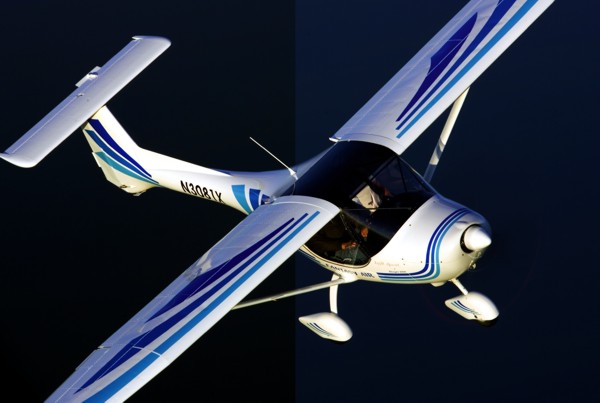
The Allegro 2000
defi nes value in
light-sport aircraft
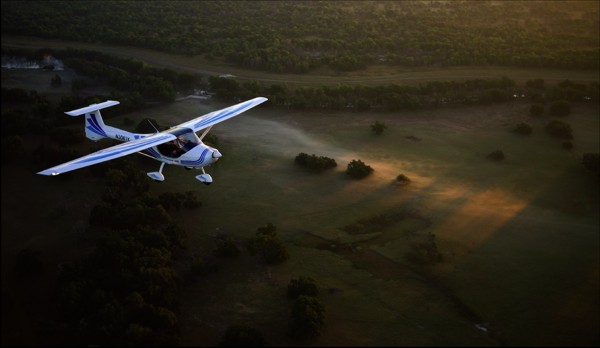
In general, most
pilots will agree the
Allegro exhibits great
performance.
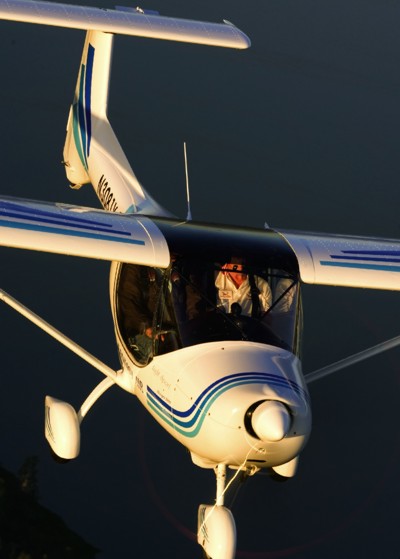
At only a shade more
than most completed kits,
this ready-to-fly beauty
comes well-loaded…

The Allegro features two-position flaps, with the switch located just forward of the brake handle of the center-mounted stick.

Customers may outfit their panel to their choosing with a combination of electronic or traditional steam gauge instruments/navigation aids.
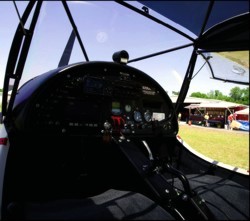
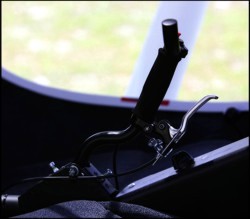

The aircraft’s standard powerplant is
the 80-hp Rotax 912 engine.
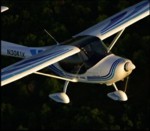
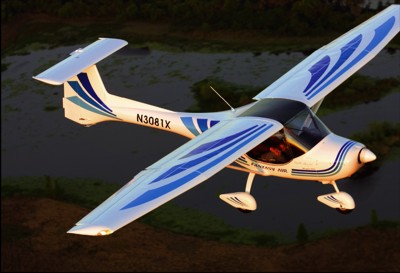
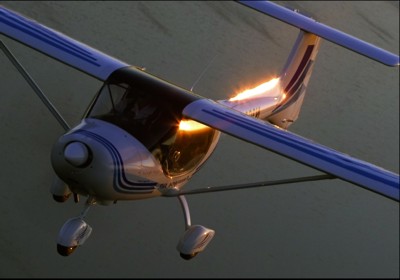
The Allegro is the value leader among LSA designs.
One year ago, the fi rst special light-sport aircraft
(S-LSA) were approved and delivery of S-LSA began.
A few brands stand above the rest in the number of
aircraft delivered. One of those is the Allegro 2000, imported into
the United States from the Czech Republic by Fantasy Air USA. Since May 19, 2005,
when the Allegro earned S-LSA approval, Fantasy Air has delivered more than 40 aircraft,
keeping owners Doug and Betty Hempstead busy.
One of the appealing factors of the Allegro 2000 is its price, which starts in the upper
$50,000 range for the flyaway version. An airplane with an attractive price has a clear
advantage over others with higher price tags. When that airplane flies well, is supported
well, and has the equipment desired by consumers, it’s likely to succeed.
Well-Established
Given its fast start, Fantasy Air USA
has reason for optimism, but the
Allegro design has a much longer
history outside this country. The
Allegro series of aircraft has been
flying for a dozen years in Europe.
Fantasy Air s.r.o., the parent
company, reports more than 450
units flying throughout the world.
Located on the Sanford-Lee
County Regional Airport in Sanford,
North Carolina, Fantasy Air USA is
developing its facility to become the
manufacturing home for the Allegro
2000 in the United States. Currently,
it is assembling the aircraft in
stages with imported parts. Later, it
hopes to fabricate more parts in the
United States. Either way, Fantasy
Air can assure buyers it will have
readily available replacement parts.
In addition, Fantasy Air offers all
airframe services, plus warranty
work, and the company operates
a flight school that provides pilot
training tailored to the Allegro 2000.
It has a network of 11 dealers to sell
and service the Allegro throughout
the United States.
When EAA took its Sport Pilot
Tour to the Phoenix area in February
2006, a first occurred-a flight
school on the fi eld, Falcon Executive
Aviation, offers sport pilot training,
and its aircraft of choice is the Allegro
2000. (See sidebar “Instructing With
the Allegro.”) But, while Fantasy Air’s
focus is on delivering ready-to-fly
Allegros for private owners, flight
schools, and rental facilities, it also
offers the aircraft as an experimental
amateur-built aircraft with a quickbuild
kit.
Modern Materials; Modern Cockpit
The Allegro’s fuselage is constructed
of a Kevlar-reinforced composite
material to which are mated
aluminum wings. On earlier models,
the wing area aft of the leading edge
D-cell was fabric, but this has given
way to full aluminum wings. The
empennage structure and covering
is also aluminum.
Although the Allegro is leaner
looking than some S-LSA on the
market, it has a generous interior
size. A tad more than 43 inches wide
at the shoulders, it is nearly 4 inches
wider than a Cessna 172 and an inch
wider than a Cessna 182.
However, I found entry into the
Allegro a bit challenging. The highwing
aircraft’s doors open upward,
but the entry space is small because
the aircraft’s cabin floor is high.
Consequently, you must bend to get
yourself inside. Luckily, the aircraft
has a center-mounted joystick,
which keeps the interior space free
of obstacles during entry.
The Allegro’s door latch works
well; a rod slides up and down a
slotted bracket and slips into a
keyhole at the top of the slot to
prop the door open. To lower the
door, you manually pull the rod
toward the inside of the plane while
pulling down on the door handle.
Once closed, a twist of a lever inserts
a different rod on the front side of
the door. This saves the weight of
gas pistons, which are common in
many LSA.
Once the door is secured, the view
is broad; the doors are full Lexan
panels, and there’s a large overhead
skylight and a wide windshield that
angles down to meet the doors. For
open-cockpit enthusiasts like me,
you can fly with the doors open up to 80 mph-perfect if you want to
do aerial photography. The factory
can also provide a sliding window in
the door. If you enjoy wind moving
through the cabin, removing the
doors entirely is a process that
“takes about three minutes,” said
Doug Hempstead. Many pilots are
enamored of open-cockpit flying.
The Allegro’s joystick is centered
between the side-by-side seats.
Most right-handed pilots will fi nd
it natural if seated in the left seat;
from the right seat, some may fi nd
its operation awkward. I thought
the center joystick worked quite
well. (I was seated on the left and
am right-handed.) The control was
fluid and produced a good response
to movement ratio. But the Allegro
does have two throttles, a feature
flight instructors will like.
A hand brake is mounted on the
front side of the joystick. Thanks to
the authority offered via hydraulic
action, your hand can adequately
apply enough brake pressure to stop
the airplane.
The Allegro’s seats adjust up
and down plus fore and aft via a
strap arrangement that is advisably
changed on the ground; you can
adjust the seats in flight, but you’d
need to be pretty flexible to do
it. The up and down adjustment
range is about 4 inches, and fore/aft
adjustment is about 6 inches. The
design’s fi rm, molded seats support
you well with good lumbar support,
most uncommon in airplane seats.
Because the seats adjust, no rudder
pedal adjustment is planned.
A two-position flap switch, located
just forward of the joystick, moves
the flaps to 15 degrees for normal
takeoffs and landings or to a deep
48 degrees for short-fi eld operations.
When retracted, the flaps go slightly
negative (about 5 degrees) in the
tradition of sailplanes, which use
negative reflex-or a slight upward
curving of the trailing edge-as a
performance enhancement. When
the flaps are being extended, an LED
flashes red. It turns green when the
flaps reach any selected position. It’s
quite simple but may not appeal to
those who like to tweak their flap
positions more subtly. Full flaps
cannot be used until the airspeed is
70 mph or less.
The instrument panel has a
modern yet practical design with
well-placed flight and engine
instruments. The panel’s relatively
low height allows good forward
visibility while taxiing. A small
horizontal shelf in the panel provides
a place to stash maps temporarily.
Another small storage area is
located under each seat, but you
can’t access these areas during flight.
A larger luggage area located behind
the seats has a lot of cubic space, but
it’s limited to 33 pounds. For most
flights in the Allegro, this area will
suffi ce. But getting large items in this
space may prove a little challenging
because the adjustable seat straps are
in the way.
The Allegro 2000 holds 14.5
gallons of fuel, giving the airplane
an endurance range of about three
hours (somewhat more in economy
cruise). A professional fuel fi ll cap
is located just below the lower edge
of the left-side door. As a design
innovation, the Allegro’s engineers
positioned the fuel tank under the
floor and ran all fuel lines under
the floor structure or forward of the
fi rewall. They implied this could be
an improved safety factor in certain
types of incidents. What I noticed was that this installation kept fuel
fumes from entering the cockpit.
Twin 6-gallon auxiliary wing
tanks are an option, giving a total
of 26.5 gallons on board. This added
fuel extends the airplane’s range to
more than fi ve hours. “The Allegro
2000 was designed for a maximum
takeoff weight of 1,232 pounds,”
Doug Hempstead said. (That was the
original weight proposed for LSA.)
Given its empty weight of about
622 pounds (depending on optional
equipment chosen), the Allegro can
claim a useful load of 610 pounds.
Subtracting 87 pounds for the
standard 14.5 gallons of fuel, the
remaining payload is an impressive
523 pounds. Even with the optional
long-range tanks, the Allegro 2000
has a 451-pound payload. This
equates to a full 33 pounds of cargo
and two 209-pound occupants, even
with fi ve hours of fuel on board.
Up We Go
The Allegro 2000 wants to fly.
I added in full power and rotated
at about 50 mph, though slightly
faster might be advised to assure
you remain well above the airplane’s
40 mph stall speed. The Allegro’s
takeoff run, at about 500 feet, is a
little longer than the average LSA;
this may be a function of its long,
tapered wing that likes to glide.
The Allegro has large ailerons that
demonstrate strong control authority
within reasonable crosswind angle
and wind speed limits. Thanks to
those large ailerons and the Allegro’s
equally strong rudder, you can hold a
good sideslip to landing, though you
may never need to do so, given the
deep flap setting available. However,
again, you can’t lower the flaps until
you’ve slowed to about 70 mph.
With flaps at the first notch,
deployment will be 15 degrees.
At this setting you can approach
comfortably while carrying 65 mph,
a speed that will allow operations at
most shorter strips. Once experienced
in the Allegro, you can use full flaps
and approach at perhaps 50 mph
to make the shortest fi elds. But the
round-out at this speed comes rather
abruptly, given the heavy drag of full
flaps. In my trials, I settled on about
55 mph and the first notch of flaps,
though that may be slightly slower
than optimal. In the event you need
to extend your approach, flying at
about 65 mph with no flaps will use
the design’s solid glide performance.
Running the Allegro through its
handling paces, I found a roll rate
of about three seconds for 45- to 45-
degree bank changes. Though quite
responsive, this is about average for
the LSA I’ve flown. However, with
the Allegro I found it was harder than
average to keep the ball in the center
of the lip/skid tube. Responsive controls suggest the plane will be
useful for training, yet it should
satisfy most recreational fliers.
While in turns, especially to your
opposite side, visibility is enhanced
by the overhead skylight and the
low instrument panel. However, the
curved-top panel does take away a
familiar reference line for holding
turns steady.
In general, most pilots will agree the
Allegro exhibits great performance.
Its glide ratio is reported as 12-to-
1; that’s substantially better than
most general aviation aircraft or
ultralights. Perhaps this long reach
is no surprise given the more than
35-foot wing on the Allegro 2000;
many LSA use wingspans in the 28-
to 30-foot range.
The Czech design uses a dualtapered
wing in the outboard wing
section, which allows the long
wing to have large ailerons without
sacrificing flap area. With 122 square
feet of wing area, the Allegro is loaded
to 10 pounds per square foot, so it
handles bumpy air with less rocking
and rolling than most lightly loaded
aircraft.
Always in Control
The Allegro’s VNE (never exceed
speed) is set at 137 mph, which is just
shy of the maximum speed allowed
for LSA (120 knots or 138 mph). That
gives the aircraft a normal cruise
speed of about 115 mph.
I commonly seek a power setting
to keep noise and vibration at a
minimum for creature comfort
(mine!). By feel, I liked about 5200 rpm on the Allegro I flew, which
produced 110-115 mph-safely
below Allegro’s VNE, but still fast
enough for touring. If you want
to stretch your fuel supply, you
can ease back to 4800 rpm where
consumption will drop to about 3.5
gph and speed will hold at about 105
mph. That 400 rpm difference also
turns out to be easier on your ears.
The Allegro’s airspeed indicator
was marked for a 45 mph stall in
the landing confi guration (bottom
of the white arc). A wide yellow
arc, from 90 mph to VNE, cautions
against flying in the upper ranges.
Keeping the Allegro within its speed
limits will prove straightforward
with the 80-hp Rotax 912, but those
electing the 100-hp model may have
to watch power dives.
While running through my
common routine of stalls, I found
some signifi cant buffeting and stick
movement preceded stall break.
When stalls break in an Allegro 2000,
one wing tended to drop, but not
with great suddenness. Normal stall
recovery easily returned the plane to
level flight with little altitude loss.
Stalls done at cruise power
(approximately 75 percent) were
more attention-getting and had
less warning; the nose can drop
noticeably. But the extreme deck
angle you reach before stall should be
all the warning you need that a stall
is imminent. The factory does not
approve spins, so I didn’t try them.
This Allegro was not fi tted with a
parachute, though the company
does offer the option if a customer
wishes.
Spend Less, Fly More
The Allegro 2000 in ready-to-fly
form powered by the 80-hp Rotax
912 engine and a three-blade
WoodComp propeller is currently
listed at $57,225. The Allegro 2000
with the 100-hp Rotax 912S is listed
at $59,850. Because the airplane
is imported, the euro currency
exchange rates can affect this fi gure;
check with Fantasy Air for the latest
prices.
Neither of these models is
stripped down. At only a shade
more than most completed kits,
this ready-to-fly beauty comes wellloaded,
including airspeed indicator,
altimeter, vertical speed indicator,
bank indicator, compass, fuel level
gauge, flap position indicator,
tachometer, water temperature,
oil temperature, oil pressure, fuel
pressure, ELT, hydraulic disc brakes
on main wheels, electrical flaps,
upholstered and carpeted cockpit,
color design choice, and electric fuel
pump and fuel drain valve.
At these prices and with these
options, the Allegro is the value leader
among LSA designs. It is no wonder
the company has enjoyed brisk sales.
Fantasy Air’s success at selling the
aircraft to some conventional GA
flight schools is further proof of the
aircraft’s ramp appeal as well as good
performance and economy.
Though the Allegro leads the fi eld
from a value standpoint, $57,000
to $59,000 may still be out of reach
for some potential buyers. Plus,
homebuilders enjoy the experience
of assembly. So, unlike many LSA
suppliers (especially importers),
Fantasy Air offers an even lower
cost option with the Allegro 2000
in kit form. You can purchase a
quick-build kit (QBK) for only
$26,125, plus freight. Build time to
assemble the aircraft is reportedly
about 190 hours. The QBK is a
partially assembled airframe with
the majority of the work fi nished for
you. Completely riveted aluminum
wings, wing struts, elevator, and
rudder are included.
Fantasy Air’s QBK contains all
electric flap control parts, the engine
cowling, pre-assembled front nosewheel
assembly, and completed
main gear legs. The fuselage comes
fully welded using factory jigging
and tooling. The wing connects,
elevator, and main gear legs are
already fi tted, and all structural
parts (wing, elevator, and main
undercarriage fi ttings) are installed
on the airframe.
A scratch builder won’t need all
this help and might look elsewhere
for a more ambitious project,
but most folks primarily looking
to reduce their cost will benefi t
from all the work Fantasy Air does
legally under experimental LSA
(E-LSA) regulations. The company
said the homebuilder’s main task is
assembling and installing the steering
components into the airframe. It
is also necessary to install the nose
wheel, some cabin parts, wingtips,
and elevator.
To the QBK price you must
add powerplant and propeller,
instruments, and paint. Taking a
base kit cost of about $28,000 with
shipping, adding an 80-hp 912
engine and engine mount kit plus
prop (about $15,000), instruments
(assuming $5,000 worth), and
fi nishing costs (about $2,000), you
will have invested about $50,000
plus a couple hundred hours of your
time. Obviously, it’s your choice
between your time and labor or the extra $7,000 to have a ready-to-fly
airplane.
Either way, you’ll spend literally
tens of thousands of dollars less than
for other LSA. You cannot compare
LSA by price alone, but no matter
how you stack up the numbers
and factor in the flight qualities of
the Allegro, you’ll come up with a
competitive airplane that should find
a market for a long time.
| Seating | 2 side-by-side |
| Empty weight | 622 pounds 1 |
| Gross weight | 1,232 pounds |
| Wingspan | 35.5 feet |
| Wing area | 122 square feet |
| Wing loading | 9.4 pounds/square ft. |
| Useful Load | 610 pounds |
| Length | 20.8 feet |
| Payload (with full fuel) | 523 pounds |
| Cabin Interior | 43 inches |
| Height | 6.5 feet |
| Fuel Capacity | 14.5 gallons 2 |
| Baggage area | aft of seats |
| Airworthiness | Certified SLSA |
| Notes: | 1 Specs with 80-hp Rotax 912; also available with 100-hp 912S 2 Two 6-gallon auxiliary tanks available. |
| Standard engine | Rotax 912UL 1 |
| Prop Diameter | 3-blade WoodComp |
| Power | 80 hp 1 |
| Power loading | 14.3 pounds/hp |
| Cruise speed | 97 knots/112 mph |
| Stall Speed | 35 knots/40 mph |
| Never exceed speed | 119 knots/137 mph |
| Rate of climb at gross | 1,000 fpm |
| Takeoff distance at gross | 490 feet |
| Landing distance at gross | 340 feet |
| Range (powered) | 350 miles / 3.5 hours |
| Fuel Consumption | about 3.5 gph |
| Notes: | 1 Also available with 100-hp 912S |


Leave a Reply